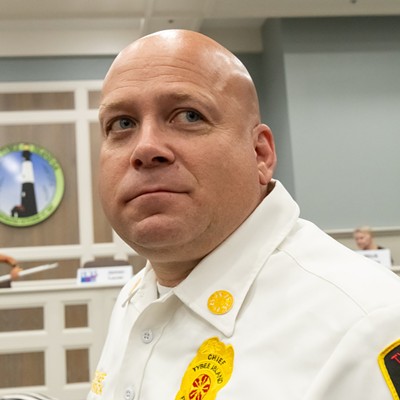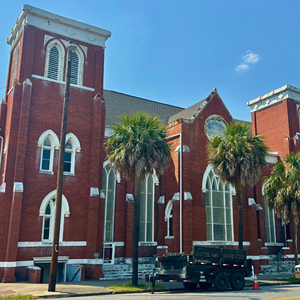Say goodbye to
The entire southeastern
“The Southeast is particularly vulnerable to the wrath of global warming,” says Stephen Smith, executive director of the
So what can one lonely individual do to save the entire planet? Quite a lot, actually, and it isn’t that hard or expensive.
You can start by reducing your carbon footprint, a measure of the impact human activities have on the environment in terms of the amount of greenhouse gases produced. This is measured in units of carbon dioxide, which accounts for 74 percent of the greenhouse gas emissions that are causing global warming.
Reduce the amount of greenhouse gases you and your household and business produce, and you reduce the amount of carbon dioxide that is released into the atmosphere.
In other words, you’ve become “carbon neutral.”
The
SACE is doing this by working with the Green Mountain Energy Company’s eMission Solutions program. With
To do this, SACE is purchasing electricity which is obtained through wind power and by planting trees. Also, SACE will purchase clean energy, also known as green power, from solar and methane sources. By taking these steps, SACE will help avoid more than 330,000 pounds of carbon dioxide every year.
How much carbon dioxide is 330,000 pounds worth? It’s equivalent to driving more than 366,000 miles.
“We hope that our purchase will serve as an example to Southern businesses that it is possible today to make your standard business operations carbon neutral and address a leading cause of global warming,” Smith says. “It’s easy. If we, a small non-profit, can do it, so can others.”
Currently, SACE has 15 staff at offices located in
Gillan Taddune is chief environmental officer for
“
Green Mountain Energy was founded in 1997 and is one of the country’s leading retail providers of cleaner electricity. It offers residential, business, institutional and governmental customers the choice of using electricity generated by wind, solar, water, geothermal, biomass or natural gas.
Founded in
The company built and operates 13 wind and solar plants of its own that are located in several states, and also buys electricity from other sources, including wind, water, solar, biomass, geothermal and natural gas.
The electricity is delivered to the customer through an existing utility company, such as the Georgia Power Co. in our area, which continues to maintain power lines and take care of outages. The existing utility company also reads the meter and resolves service issues, and customers are still connected to the same regional power grid they were before.
The difference is that the source of the electricity is renewable. It doesn’t just burn up and disappear the way fossil fuels such as coal do. Most electricity is made from the burning of fossil fuels. This causes air pollution, which the less polluting sources don’t.
Wind energy comes from turbines mounted on towers. It currently is the fastest-growing renewable energy source in the world, and it has the bonus of being 100 percent pollution free.
Geothermal energy comes from heat trapped within the earth’s crust, the kind of energy that is seen in volcanoes and geysers. Geothermal power plants use steam and hot water that is trapped underground to convert into electricity.
“We just started the division called eMission Solutions,” says Andrew Noel, director of eMissions. “It’s got its own name, but it’s under the umbrella of
No company is too small or large to do this, Noel says. “We recently worked with a company to help determine the footprint of their manufacturing process,” he says.
Up to that point of the process, eMission Solutions provides the profile at no cost. If the company is interested in reducing emissions, an offset portfolio is developed.
Not only is the company given solutions for its problems, it learns how to explain its program to others. “We give them the language so they will know how to talk to their employees, customers, shareholders and the media about it,” Noel says.
Cutting emissions is a vital step to stopping global warming, Noel says. “It’s important from an environmental perspective to do what we can to combat global climate changes,” he says.
“We’re providing solutions to problems many businesses see they have,” Noel says. “We make the process easy to understand and provide a cost-effective way to do it.”
There are solutions and companies are seeking them out -- even though they aren’t required to, Noel says. “Right now, we exist in a voluntary market,” he says.
“There is no cap on carbon dioxide. As we exist in a voluntary market, the unique thing is that we are starting to see businesses step up and take the responsibility for their own carbon footprints,” Noel says.
“They learn about it and take action to reduce it.”
At the present time, coal is the predominant source of energy in the South, including
There are eight coal-fired power plants in
• A rise in sea level that would cause erosion, flooding and loss of ocean and river buffers.
• A loss of biodiversity because niche species may find it difficult to adapt to the higher temperatures, more frequent storms and coastal habitat loss.
• A decrease in the standard of living as tropical diseases increase, respiratory disorders increase because there is more smog, and heat-related illnesses and deaths increase while potable water decreases in coastal regions such as ours.
• An economic setback would occur as the tourism, real estate and insurance industries all suffer from property loss caused by more frequent storms of greater intensity.
SACE Safe Energy Director Sara Barczak is based in SACE’s
“My area focuses on watchdogging nuclear energy,” Barczak says. “We wanted not only to talk the talk, but to walk the walk.”
The fact that SACE is able to help reduce pollution is exciting, Barczak. “If even a nonprofit with limited financial resources can make a difference, anyone can,” she says.
“The main message we want to get out is that it is easy and simple and you can do it now,” Barczak says. “You don’t have to wait until the government has a program, you can do it now, on your own.”
It is particularly important for SACE to undertake this step in its
“This was a real priority in our region, which is particularly at risk because of sea rise and the hurricane potential,” she says.
But the issue truly is one of importance to everyone, Barczak says. “It’s a global issue,” she says. “Depending on where you live, you could be more vulnerable to the impact of global warming.”
To begin the process of going carbon neutral, SACE staff at first had to figure out how much of a problem they had. “Without hiring some special consultant, we were able to do an inhouse assessment,” Barczak says.
“At the start, we all had to fill out spread sheets,” she says. “We answered questions -- how many miles do we drive to work? How many flights do we take every year? We counted up the appliances in our office and figured the square footage.”
After determining all those factors, SACE staff had to figure out a way to go carbon neutral.
“We offset all electrical usage by purchasing renewable energy credits through the Green Mountain Energy Co.,” Barczak says.
“We don’t have a lot of green power options in this region,” she says. “We’re buying our power from the
The fact that the Southeast is particularly vulnerable to the effects of global warming would seem to encourage construction of alternative energy sources, such as wind farms or solar plants. “The Southeast relies so much on coal and nuclear power,” Barczak says.
“Our choices are limited,” she says. “That’s not fair.”
SACE also is planting trees in the
“We’re helping to restore trees in the Southeast,” she says. “Trees pull carbon dioxide and store it, keeping it from being released.”
Although it is possible to become carbon neutral without having a government program in place, Barczak says it’s important to make lawmakers understand how concerned their constituents are about global warming.
“It is most important to send the message to policy makers that people are concerned about this,” she says. “Maybe they can put policy forward. If they don’t hear from people, they’re not going to consider it an issue.”
In addition to the changes at work, Barczak has also taken steps to make her home carbon neutral. “We just bought a new car,” she says.
The car is a hybrid. Hybrid cars run off a rechargeable battery and gasoline, rather than just gasoline.
In a hybrid car, batteries help to reduce fuel emissions because the engine draws on the battery and not gasoline when accelerating. Hybrid gasoline motors can shut off when the car is stopped and run off their electricity.
“We’re going down to a one-car family,” Barczak says. “We’re able to do that in part because we have chosen to live as close as possible to work. We can walk or bike.”
Homeowners can cut energy bills and help protect the environment by making sure to purchase Energy Star appliances. They also can use compact fluorescent light bulbs.
“They’re more expensive, but they use a quarter of the energy that a standard light bulb uses and they last seven times longer,. In the first month, you’ll see a difference in the utility bill,” Barczak says.
“The only negative of using compact fluorescent lights is that you can’t put them on a dimmer switch,” she says. “But you can use them in a porch light. If you buy one or two at a time and spread it out, it’s not that expensive, and you will see a difference.”
Making changes at home is just as important as making changes at work. According to
• Purchasing energy-efficient products.
• Conduct a home energy audit by checking for door and window air leaks, insufficient insulation, inefficient heating and cooling equipment and energy-draining lighting.
• Replace old windows.
• Switch to compact fluorescent light bulbs.
• Consider a heat pump.
• Set your thermostat to 78 degrees or higher in warm weather when you are at home and 85 degrees when you’re not. You will save up to 3 percent off your bill for each degree the thermostat is set above 72 degrees.
• Don’t line your oven with foil and avoid the habit of automatically preheating the oven every time you cook.
• Replace air filters in air conditioners and furnaces.
• Adjust your hot water heater down to 120 degrees to reduce hot water costs by as much as 50 percent. If your water storage tank feels warm to the touch, it’s probably losing heat and needs additional insulation on its exterior.
• Limit fireplace use, which exhausts as much as 24,000 cubic feet of air per hour through the chimney.
• Fix dripping faucets, which can waste 212 gallons of water each month.
• Plant shrubs and bushes about a foot from your house. The dead air spaces will help insulate your house in both summer and winter.
Enacting conservation measures in a business can help the business run more efficiently. “What business wouldn’t want to be more efficient?” Barczak asks.
“As prices keep going up, it makes more economical sense. The more efficient you are, the more solid the bottom line will be,” she says. “No one wants to be wasteful.”
By joining forces with
SACE also is supporting the planting of 475 trees in the
“Global warming is the toughest environmental problem we currently face,” Smith says. “
Business owners and managers who are interested in taking the SACE challenge and reducing their carbon footprint can find more information at www.cleanenergy.org. For more information on obtaining green power for business or personal use, visit www.greenmountain.com.
To comment, e-mail us at

























